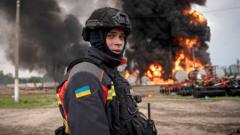In the wake of Russia's full-scale invasion of Ukraine, photojournalism has acquired a profound urgency and depth, with hundreds of photographers seeking to document the conflict's human ramifications. As many of these photographers share their narratives and artworks, their experiences shine a light on the emotional burden that comes with capturing the realities of war.
Before the conflict escalated, Vlada and Kostiantyn Liberov were known for their work in wedding and portrait photography in Odesa. However, they swiftly shifted their lens to unveil the stark realities of the war, capturing what Vlada describes as "the story of love transformed into documenting Russian war crimes." The couple's courageous commitment to their craft has not come without personal sacrifice, as evidenced by Vlada's lasting injury from an explosion in Donetsk.
Kostiantyn's poignant photograph of a soldier grieving a fallen comrade during an offensive into Russia illustrates the nuanced emotional landscape of the military experience. "Losing a friend in combat on enemy soil is a heavy burden," he admitted, reflecting on the chaos of their mission. The couple continually grapples with the emotional toll of their work, often finding it painful to discuss their experiences, though they recognize the deep connection forged through shared trauma.
Valeria Demenko, whose photography follows Ukraine's emergency services, brings to light the harrowing realities faced by first responders. "The unknown dangers make each day a new challenge," she noted, recalling a tragic incident involving a collapsed building where victims were trapped. Her determination to document these events underscores a desire for the world to witness the ongoing suffering inflicted by the conflict.
Alexander Ermochenko, an established photojournalist from Donetsk, has dedicated over a decade to capturing life in a war-torn region, emphasizing the universal pain of displacement and destruction. He describes how, despite the war's relentless march, life persists amid the chaos. His images aim to convey a sense of shared humanity that transcends borders and conflicts.
In Kyiv, Alina Smutko reflects on the instability that the war has imposed on her daily existence, highlighting the need for resilience amid frequent attacks. "Every day presents new risks, but I feel compelled to document these stories" she stated, underlining her commitment to telling the truth through her art.
Each image captured by these intrepid photojournalists serves as a testament to the resilience of the Ukrainian spirit, as they shine a light on the bravery and vulnerability found in both soldiers and civilians. In sharing their stories, they refuse to allow the world's focus to veer away from the real human cost of this ongoing crisis. Their work reminds us that true reporting entails exposing the intricacies of life in wartime, preserving the memory of loss while also celebrating moments of unexpected joy amid the conflict.
Before the conflict escalated, Vlada and Kostiantyn Liberov were known for their work in wedding and portrait photography in Odesa. However, they swiftly shifted their lens to unveil the stark realities of the war, capturing what Vlada describes as "the story of love transformed into documenting Russian war crimes." The couple's courageous commitment to their craft has not come without personal sacrifice, as evidenced by Vlada's lasting injury from an explosion in Donetsk.
Kostiantyn's poignant photograph of a soldier grieving a fallen comrade during an offensive into Russia illustrates the nuanced emotional landscape of the military experience. "Losing a friend in combat on enemy soil is a heavy burden," he admitted, reflecting on the chaos of their mission. The couple continually grapples with the emotional toll of their work, often finding it painful to discuss their experiences, though they recognize the deep connection forged through shared trauma.
Valeria Demenko, whose photography follows Ukraine's emergency services, brings to light the harrowing realities faced by first responders. "The unknown dangers make each day a new challenge," she noted, recalling a tragic incident involving a collapsed building where victims were trapped. Her determination to document these events underscores a desire for the world to witness the ongoing suffering inflicted by the conflict.
Alexander Ermochenko, an established photojournalist from Donetsk, has dedicated over a decade to capturing life in a war-torn region, emphasizing the universal pain of displacement and destruction. He describes how, despite the war's relentless march, life persists amid the chaos. His images aim to convey a sense of shared humanity that transcends borders and conflicts.
In Kyiv, Alina Smutko reflects on the instability that the war has imposed on her daily existence, highlighting the need for resilience amid frequent attacks. "Every day presents new risks, but I feel compelled to document these stories" she stated, underlining her commitment to telling the truth through her art.
Each image captured by these intrepid photojournalists serves as a testament to the resilience of the Ukrainian spirit, as they shine a light on the bravery and vulnerability found in both soldiers and civilians. In sharing their stories, they refuse to allow the world's focus to veer away from the real human cost of this ongoing crisis. Their work reminds us that true reporting entails exposing the intricacies of life in wartime, preserving the memory of loss while also celebrating moments of unexpected joy amid the conflict.


















